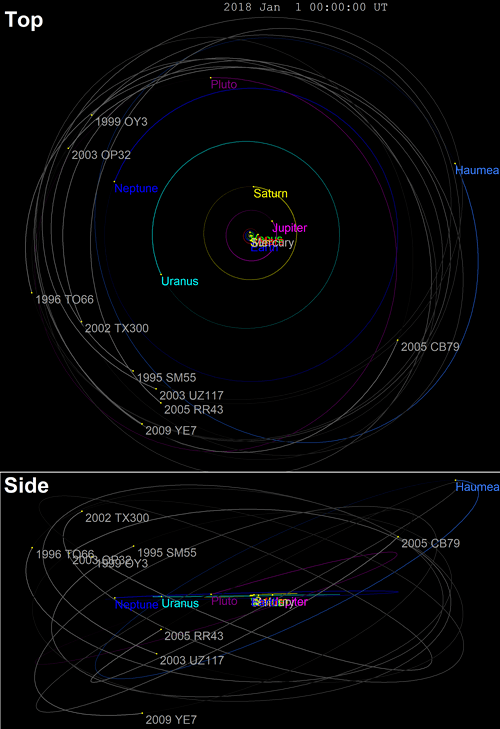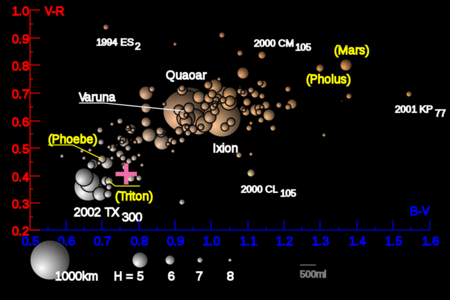(145453) 2005 RR43
 (145453) 2005 RR43 among other Haumea family objects | |
| Discovery[1] | |
|---|---|
| Discovered by |
A. C. Becker A. W. Puckett J. M. Kubica |
| Discovery site | APO |
| Discovery date | 9 September 2005 |
| Designations | |
| MPC designation | (145453) 2005 RR43 |
|
cubewano[2] extended (DES)[3] | |
| Orbital characteristics[1] | |
| Epoch 13 January 2016 (JD 2457400.5) | |
| Uncertainty parameter 3 | |
| Observation arc | 14301 days (39.15 yr) |
| Aphelion | 49.050 AU (7.3378 Tm) |
| Perihelion | 37.276 AU (5.5764 Tm) |
| 43.163 AU (6.4571 Tm) | |
| Eccentricity | 0.13639 |
| 283.58 yr (103578 d) | |
Average orbital speed | 0.00346°/d |
| 43.576° | |
| 0° 0m 12.513s / day | |
| Inclination | 28.506° |
| 85.852° | |
| 279.66° | |
| Earth MOID | 36.394 AU (5.4445 Tm) |
| Jupiter MOID | 32.9176 AU (4.92440 Tm) |
| Physical characteristics | |
| Dimensions |
252 km[4] 213 km[5] |
| 7.87 h (0.328 d) | |
Sidereal rotation period | 7.87 h[4] |
|
0.703±0.021 (wavelength: 1.5 μm) 0.828±0.049 (wavelength: 2.0 μm)[6] | |
|
B−V=0.77, V−R=0.41[7] B0−V0=0.790[8] | |
|
4.1[1][9] 4.0[4][6] 4.4 (per Brown)[5] | |
|
| |
(145453) 2005 RR43, also written as (145453) 2005 RR43, is a trans-Neptunian object (TNO) estimated to be about 250 km in diameter.[4][5] It was discovered on 9 September 2005 by Andrew Becker, Andrew Puckett and Jeremy Kubica at Apache Point Observatory in Sunspot, New Mexico. It is possibly a dwarf planet.[10]
Origin
Based on their common pattern of IR water-ice absorptions, neutral visible spectrum,[6] and the clustering of their orbital elements, the other KBOs 1995 SM55, (19308) 1996 TO66, (55636) 2002 TX300 and (120178) 2003 OP32 appear to be collisional fragments broken off the dwarf planet Haumea.
Surface
The surface is covered by water ice as attested by deep absorption at 1.5 and 2 μm in the infrared spectrum and neutral (i.e. non-red) colour. Scattering models reveal that the observed water ice is, at least in a significant fraction, crystalline and organics, detected on the surface of many TNOs, are completely absent.[6] These physical and orbital characteristics common with Haumea led to suggestion that 2005 RR43 is a member of the Haumea collisional family. The object, together with other members of the family ((19308) 1996 TO66, (24835) 1995 SM55, (55636) 2002 TX300 and (120178) 2003 OP32), would be created from ice mantle ejected from the proto-Haumea as result of a collision with another large (around 1,660 kilometres (1,030 mi)) body.[11]
 The + marks 2005 RR43 (B−V=0.77, V−R=0.41) on this color plot of TNOs. All the other Haumea-family members are located to the lower left of this point. |
See also
References
- 1 2 3 "JPL Small-Body Database Browser: 145453 (2005 RR43)" (2014-01-02 last obs). Retrieved 7 April 2016.
- ↑ "MPEC 2009-R09 :Distant Minor Planets (2009 SEPT. 16.0 TT)". IAU Minor Planet Center. 2009-09-04. Retrieved 2011-01-08.
- ↑ Marc W. Buie. "Orbit Fit and Astrometric record for 145453" (2008-12-06 using 140 observations). SwRI (Space Science Department). Retrieved 2009-10-04.
- 1 2 3 4 Carry, Benoit; Snodgrass, Colin; Lacerda, Pedro; Hainaut, Olivier; Dumas, Christophe (16 July 2012). "Characterisation of candidate members of (136108) Haumea's family: II. Follow-up observations" (PDF). Astronomy & Astrophysics. EDP Sciences. 544: A137. arXiv:1207.6491. Bibcode:2012A&A...544A.137C. doi:10.1051/0004-6361/201219044. Archived from the original (PDF) on 7 November 2014. Retrieved 8 June 2014.
- 1 2 3 Michael E. Brown. "How many dwarf planets are there in the outer solar system?". Archived from the original on 2011-10-18. Retrieved 2014-11-07.
- 1 2 3 4 Pinilla-Alonso, N.; Licandro, J.; Gil-Hutton, R.; Brunetto, R. (June 2007). "The water ice rich surface of (145453) 2005 RR43: a case for a carbon-depleted population of TNOs?" (PDF). Astronomy and Astrophysics. 468 (1): L25. arXiv:astro-ph/0703098. Bibcode:2007A&A...468L..25P. doi:10.1051/0004-6361:20077294.
- ↑ Snodgrass, Carry; Dumas, Hainaut (16 December 2009). "Characterisation of candidate members of (136108) Haumea's family". Astronomy and Astrophysics. 511: A72. arXiv:0912.3171. Bibcode:2010A&A...511A..72S. doi:10.1051/0004-6361/200913031.
- ↑ David L. Rabinowitz; Bradley E. Schaefer; Martha W. Schaefer; Suzanne W. Tourtellotte (2008). "The Youthful Appearance of the 2003 EL61 Collisional Family". The Astronomical Journal. 136: 1502–1509. arXiv:0804.2864. Bibcode:2008AJ....136.1502R. doi:10.1088/0004-6256/136/4/1502.
- ↑ (145453) = 2005 RR43 Orbit
- ↑ Tancredi, Gonzalo (2010). "Icy Dwarf Planets and TNOs". p. 14. Retrieved August 27, 2015.
- ↑ Michael E. Brown; Kristina M. Barkume; Darin Ragozzine; Emily L. Schaller (2007). "A collisional family of icy objects in the Kuiper belt". Nature. 446 (7133): 294–296. Bibcode:2007Natur.446..294B. doi:10.1038/nature05619. PMID 17361177.
External links
- List of TNOs, Minor Planet Center
- (145453) 2005 RR43 Precovery Images
- (145453) 2005 RR43 at the JPL Small-Body Database

_(cropped).jpg)
